Business Research Methodology: Full Service vs. Low Cost Airlines
VerifiedAdded on 2020/05/28
|9
|1401
|88
Report
AI Summary
This report presents a business research methodology analysis of the airline industry, focusing on the competitive dynamics between Full Service Carriers (FSCs) and Low Cost Carriers (LCCs). The research employs both survey questionnaires with closed-ended questions and interviews with open-ended questions to understand factors influencing customer behavior, such as brand image, experience quality, and satisfaction. The survey questions explore the impact of cost, brand perception, and service quality on customer preferences. The interview questions delve into the industry's evolution, the role of cost in influencing customer choices, and the competitive pressures faced by FSCs. The report also includes a brief analysis of the research methodology, emphasizing ethical considerations, data confidentiality, and the steps taken to ensure a comprehensive understanding of the airline market. The findings aim to provide insights into the future behavior of customers and the challenges and opportunities for both FSCs and LCCs.
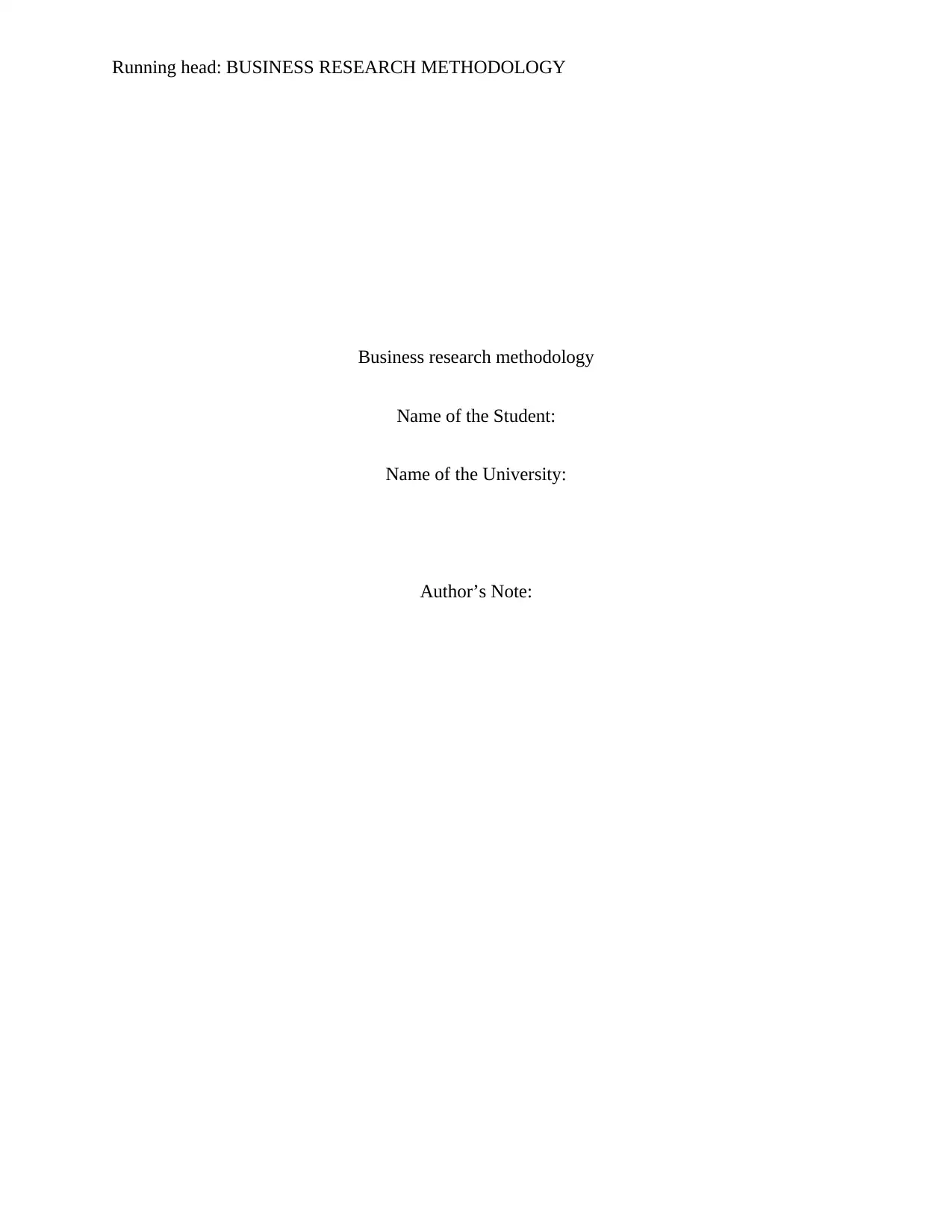
Running head: BUSINESS RESEARCH METHODOLOGY
Business research methodology
Name of the Student:
Name of the University:
Author’s Note:
Business research methodology
Name of the Student:
Name of the University:
Author’s Note:
Paraphrase This Document
Need a fresh take? Get an instant paraphrase of this document with our AI Paraphraser
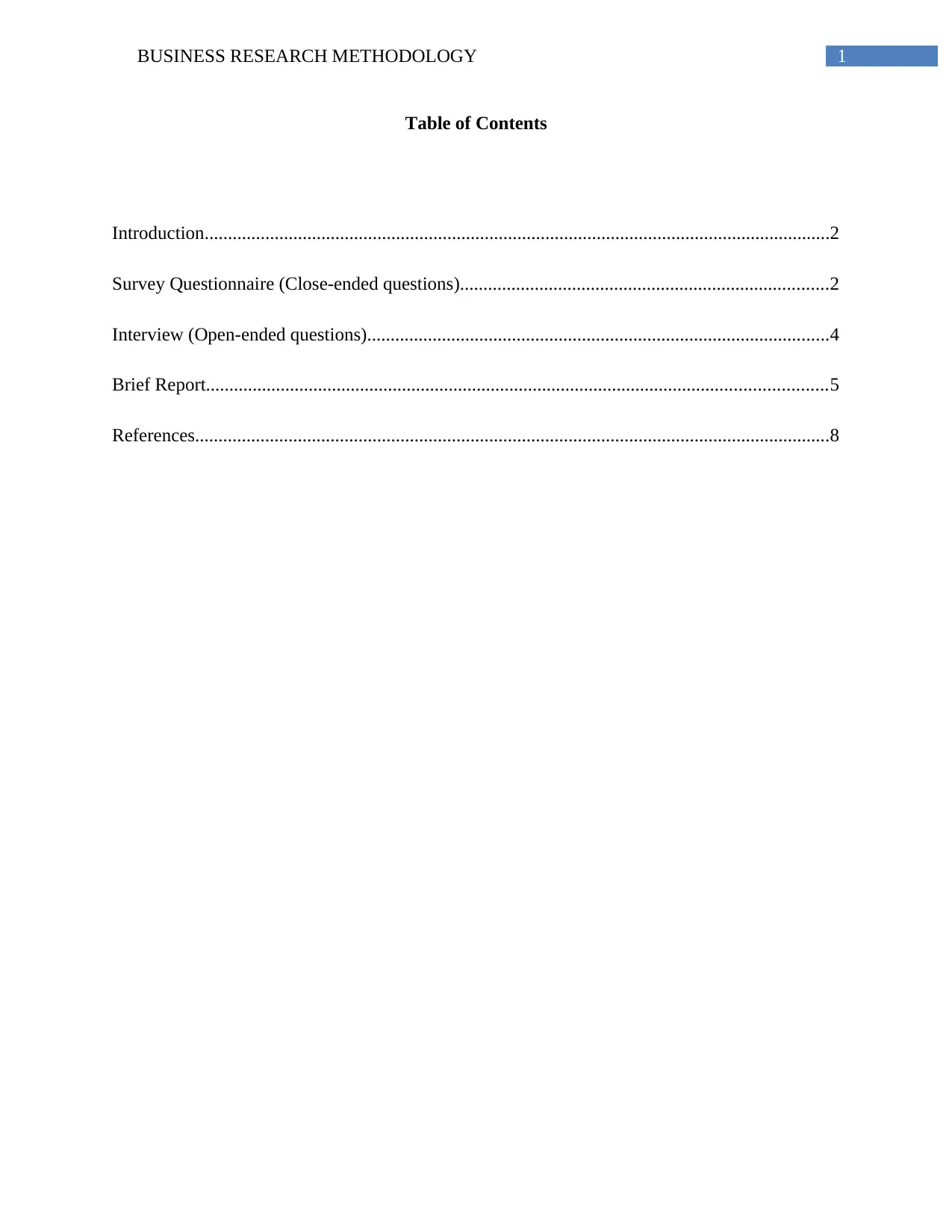
1BUSINESS RESEARCH METHODOLOGY
Table of Contents
Introduction......................................................................................................................................2
Survey Questionnaire (Close-ended questions)...............................................................................2
Interview (Open-ended questions)...................................................................................................4
Brief Report.....................................................................................................................................5
References........................................................................................................................................8
Table of Contents
Introduction......................................................................................................................................2
Survey Questionnaire (Close-ended questions)...............................................................................2
Interview (Open-ended questions)...................................................................................................4
Brief Report.....................................................................................................................................5
References........................................................................................................................................8

2BUSINESS RESEARCH METHODOLOGY
Introduction
The aim of the survey questionnaire is to develop a better understanding of the factors
such as brand image, experience quality and satisfaction that influences the future behavior of
the Full Service Carriers customers and the Low Cost Carriers customers. The survey is
conducted in order to determine the rapid growth of the Low Cost Carriers that is building a
fierce and competitive market for the Full Service Carriers. Thus, it is essential for the
Department of Infrastructure and Transport to understand and predict the future behaviors of the
customers for the FSCs and the LCCs.
Survey Questionnaire (Close-ended questions)
1) How long have you been working in the airline industry?
3-5 years
6-12 years
13- 19 years
20 years and above
2) Has cost affected the demand for travel among the customers?
Yes
No
May be
3) Has the rise of the Low Carrier Cost hampered the Full Service Carriers?
Yes
No
May be
Introduction
The aim of the survey questionnaire is to develop a better understanding of the factors
such as brand image, experience quality and satisfaction that influences the future behavior of
the Full Service Carriers customers and the Low Cost Carriers customers. The survey is
conducted in order to determine the rapid growth of the Low Cost Carriers that is building a
fierce and competitive market for the Full Service Carriers. Thus, it is essential for the
Department of Infrastructure and Transport to understand and predict the future behaviors of the
customers for the FSCs and the LCCs.
Survey Questionnaire (Close-ended questions)
1) How long have you been working in the airline industry?
3-5 years
6-12 years
13- 19 years
20 years and above
2) Has cost affected the demand for travel among the customers?
Yes
No
May be
3) Has the rise of the Low Carrier Cost hampered the Full Service Carriers?
Yes
No
May be
⊘ This is a preview!⊘
Do you want full access?
Subscribe today to unlock all pages.

Trusted by 1+ million students worldwide
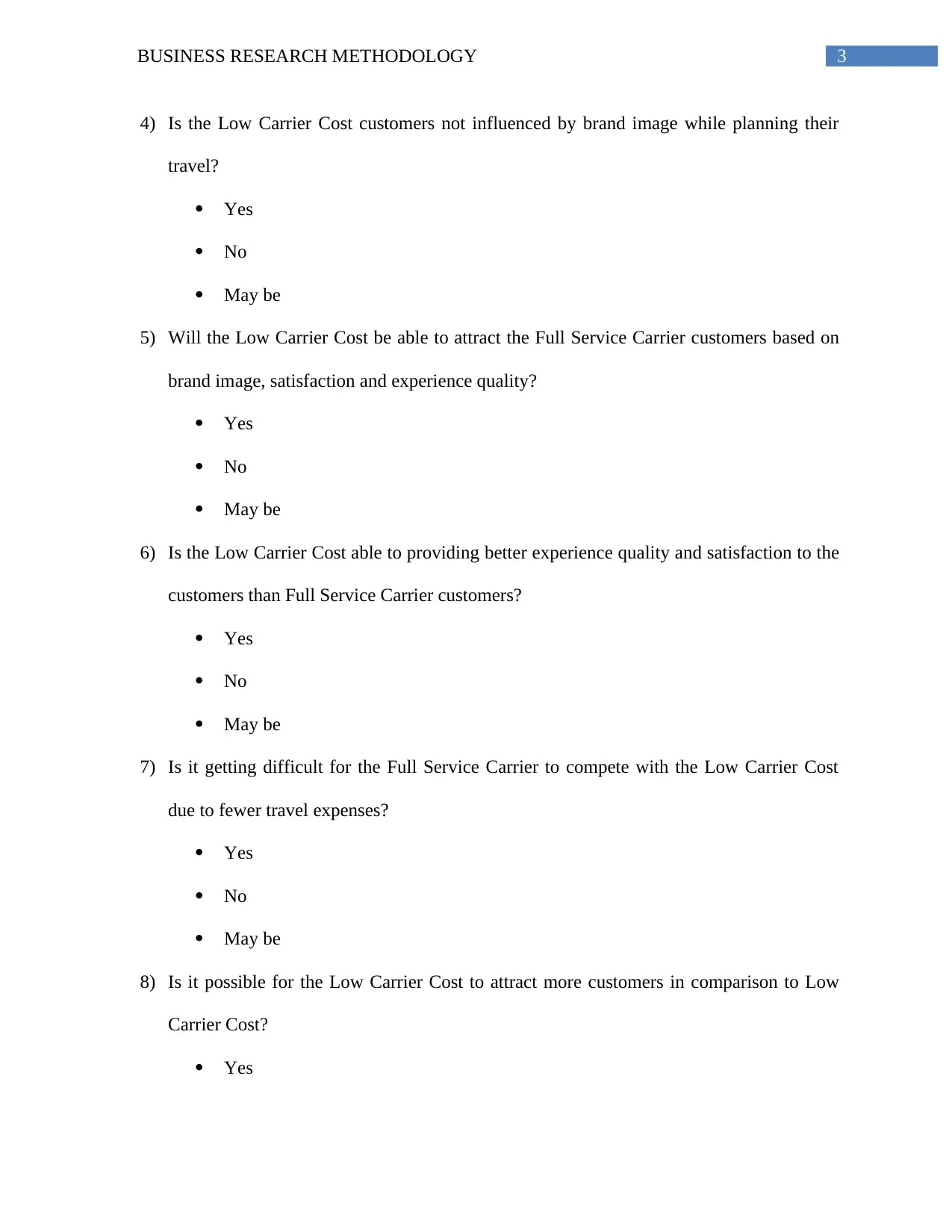
3BUSINESS RESEARCH METHODOLOGY
4) Is the Low Carrier Cost customers not influenced by brand image while planning their
travel?
Yes
No
May be
5) Will the Low Carrier Cost be able to attract the Full Service Carrier customers based on
brand image, satisfaction and experience quality?
Yes
No
May be
6) Is the Low Carrier Cost able to providing better experience quality and satisfaction to the
customers than Full Service Carrier customers?
Yes
No
May be
7) Is it getting difficult for the Full Service Carrier to compete with the Low Carrier Cost
due to fewer travel expenses?
Yes
No
May be
8) Is it possible for the Low Carrier Cost to attract more customers in comparison to Low
Carrier Cost?
Yes
4) Is the Low Carrier Cost customers not influenced by brand image while planning their
travel?
Yes
No
May be
5) Will the Low Carrier Cost be able to attract the Full Service Carrier customers based on
brand image, satisfaction and experience quality?
Yes
No
May be
6) Is the Low Carrier Cost able to providing better experience quality and satisfaction to the
customers than Full Service Carrier customers?
Yes
No
May be
7) Is it getting difficult for the Full Service Carrier to compete with the Low Carrier Cost
due to fewer travel expenses?
Yes
No
May be
8) Is it possible for the Low Carrier Cost to attract more customers in comparison to Low
Carrier Cost?
Yes
Paraphrase This Document
Need a fresh take? Get an instant paraphrase of this document with our AI Paraphraser
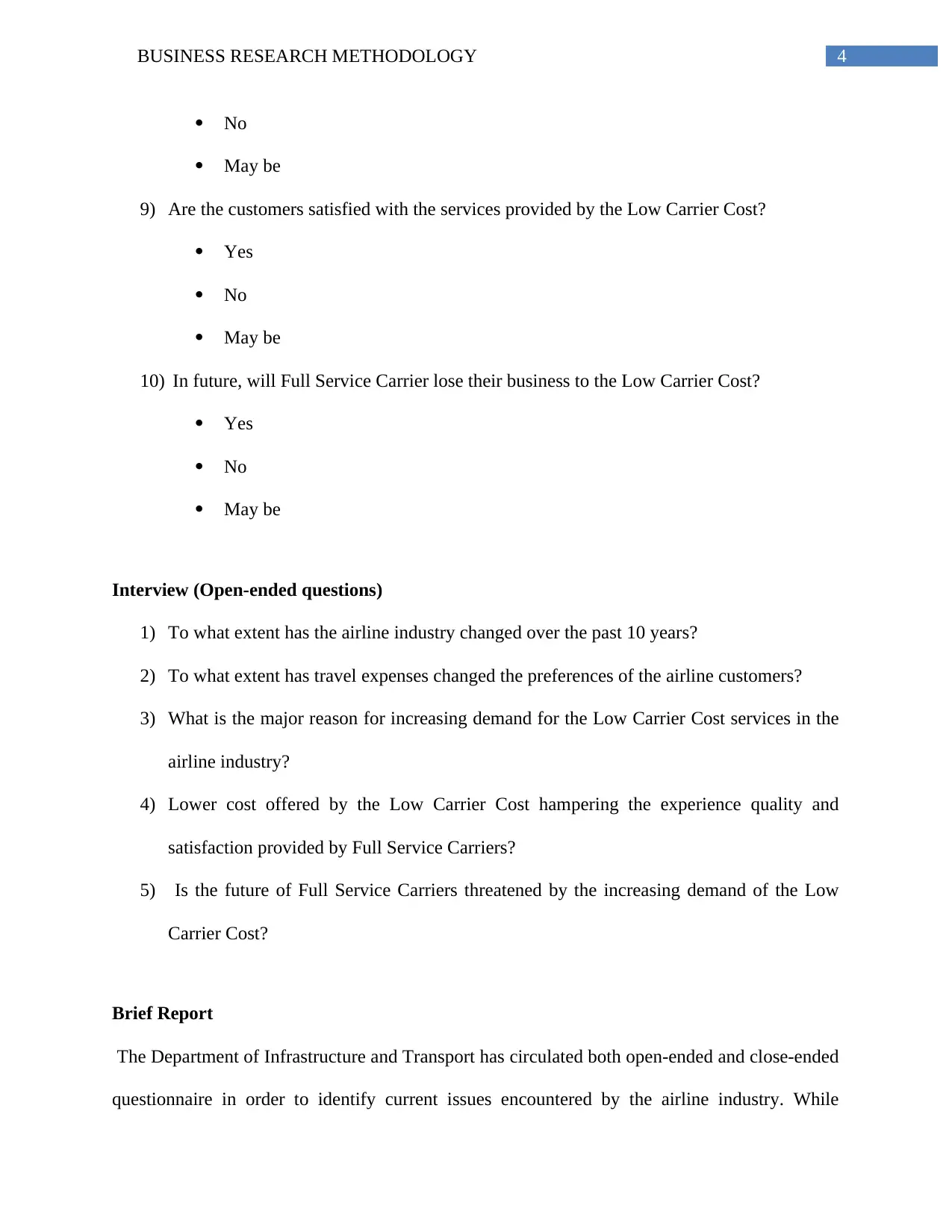
4BUSINESS RESEARCH METHODOLOGY
No
May be
9) Are the customers satisfied with the services provided by the Low Carrier Cost?
Yes
No
May be
10) In future, will Full Service Carrier lose their business to the Low Carrier Cost?
Yes
No
May be
Interview (Open-ended questions)
1) To what extent has the airline industry changed over the past 10 years?
2) To what extent has travel expenses changed the preferences of the airline customers?
3) What is the major reason for increasing demand for the Low Carrier Cost services in the
airline industry?
4) Lower cost offered by the Low Carrier Cost hampering the experience quality and
satisfaction provided by Full Service Carriers?
5) Is the future of Full Service Carriers threatened by the increasing demand of the Low
Carrier Cost?
Brief Report
The Department of Infrastructure and Transport has circulated both open-ended and close-ended
questionnaire in order to identify current issues encountered by the airline industry. While
No
May be
9) Are the customers satisfied with the services provided by the Low Carrier Cost?
Yes
No
May be
10) In future, will Full Service Carrier lose their business to the Low Carrier Cost?
Yes
No
May be
Interview (Open-ended questions)
1) To what extent has the airline industry changed over the past 10 years?
2) To what extent has travel expenses changed the preferences of the airline customers?
3) What is the major reason for increasing demand for the Low Carrier Cost services in the
airline industry?
4) Lower cost offered by the Low Carrier Cost hampering the experience quality and
satisfaction provided by Full Service Carriers?
5) Is the future of Full Service Carriers threatened by the increasing demand of the Low
Carrier Cost?
Brief Report
The Department of Infrastructure and Transport has circulated both open-ended and close-ended
questionnaire in order to identify current issues encountered by the airline industry. While

5BUSINESS RESEARCH METHODOLOGY
developing the questionnaire, the Department of Infrastructure and Transport considered the
current issues of increased competition faced by the airline industry.
The structure of the questionnaire highlights both open-ended and close-ended questions.
The open-ended questions were developed by the Department of Infrastructure and
Transport in order to gather and develop a deeper understanding about the fierce and
tough competition currently faced in the airline industry due to the rise of the Low Cost
Carrier. Having open-ended questions provided an opportunity for the respondents to
share their views and opinions in detail (Nordgaard, Sass and Parnas 2013). As a result, it
was easier to understand the factors that have helped Low Cost Carrier to gain more
popularity compared to Full Service Carriers. Moreover, open-ended questions also
allowed the researcher to analyze whether the customers are considering money or travel
expenses over the brand image, experience quality and satisfaction. Having open-ended
questions allowed the researcher to analyze the perspectives and opinions of the
management in terms of the current competition reigning in the airline industry (Marz
and Kelchtermans 2013). One of the drawbacks in the open-ended question is that it was
time-consuming, as the respondents had huge data to share. Additionally, the interview
had to be recorded and transcribed later for analyzing it. Thus, even though open-ended
questions provided a deeper understanding of the current airline situation, the process
was time-consuming and difficult to analyze (Koskei and Simiyu 2015).
The close-ended questions allowed the researcher to gather data from a larger population.
In the case of close-ended questions, the respondents were provided with questions and
options and were asked to select the most appropriate option from the ones provided
(Kaine et al. 2013). The set of 10 questions with options was developed by considering
developing the questionnaire, the Department of Infrastructure and Transport considered the
current issues of increased competition faced by the airline industry.
The structure of the questionnaire highlights both open-ended and close-ended questions.
The open-ended questions were developed by the Department of Infrastructure and
Transport in order to gather and develop a deeper understanding about the fierce and
tough competition currently faced in the airline industry due to the rise of the Low Cost
Carrier. Having open-ended questions provided an opportunity for the respondents to
share their views and opinions in detail (Nordgaard, Sass and Parnas 2013). As a result, it
was easier to understand the factors that have helped Low Cost Carrier to gain more
popularity compared to Full Service Carriers. Moreover, open-ended questions also
allowed the researcher to analyze whether the customers are considering money or travel
expenses over the brand image, experience quality and satisfaction. Having open-ended
questions allowed the researcher to analyze the perspectives and opinions of the
management in terms of the current competition reigning in the airline industry (Marz
and Kelchtermans 2013). One of the drawbacks in the open-ended question is that it was
time-consuming, as the respondents had huge data to share. Additionally, the interview
had to be recorded and transcribed later for analyzing it. Thus, even though open-ended
questions provided a deeper understanding of the current airline situation, the process
was time-consuming and difficult to analyze (Koskei and Simiyu 2015).
The close-ended questions allowed the researcher to gather data from a larger population.
In the case of close-ended questions, the respondents were provided with questions and
options and were asked to select the most appropriate option from the ones provided
(Kaine et al. 2013). The set of 10 questions with options was developed by considering
⊘ This is a preview!⊘
Do you want full access?
Subscribe today to unlock all pages.

Trusted by 1+ million students worldwide
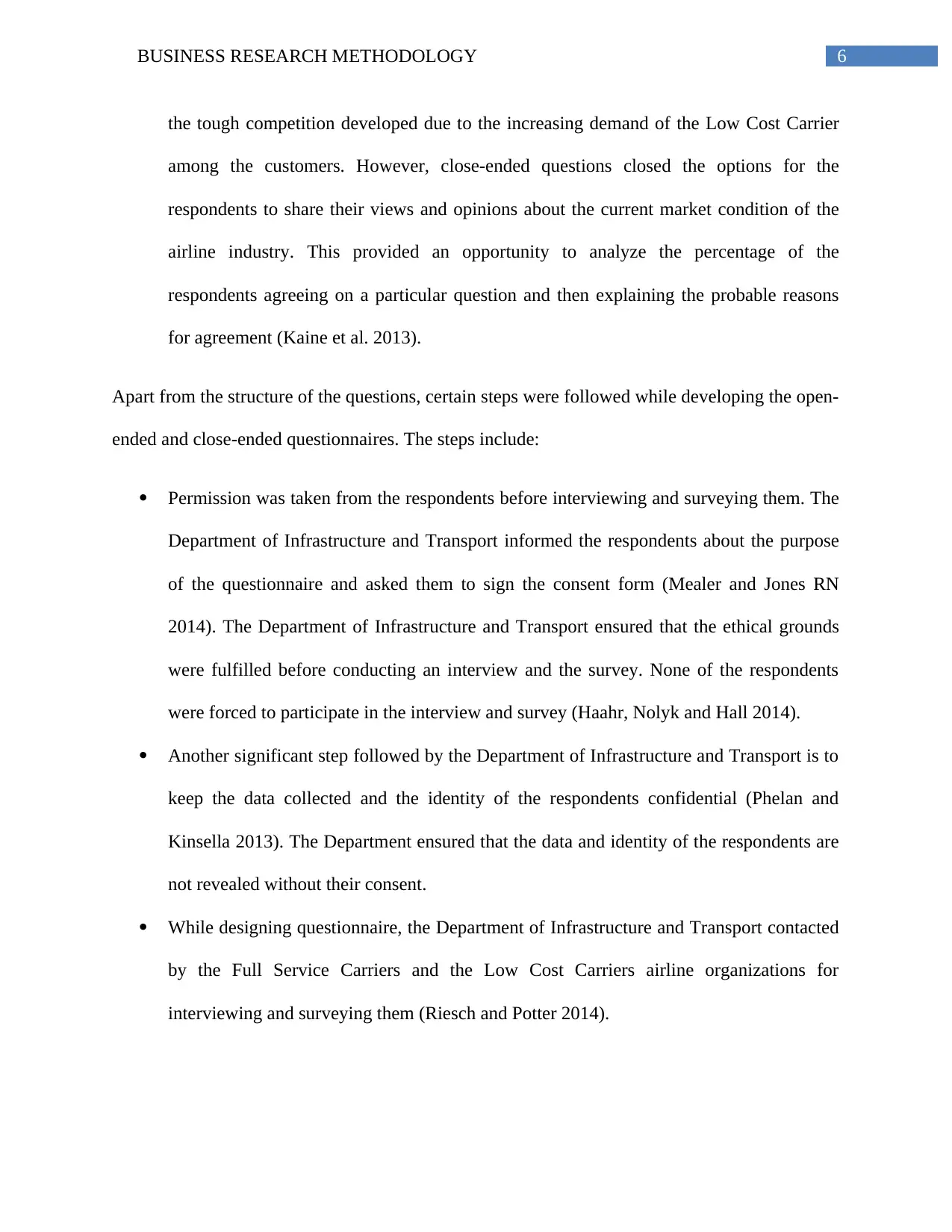
6BUSINESS RESEARCH METHODOLOGY
the tough competition developed due to the increasing demand of the Low Cost Carrier
among the customers. However, close-ended questions closed the options for the
respondents to share their views and opinions about the current market condition of the
airline industry. This provided an opportunity to analyze the percentage of the
respondents agreeing on a particular question and then explaining the probable reasons
for agreement (Kaine et al. 2013).
Apart from the structure of the questions, certain steps were followed while developing the open-
ended and close-ended questionnaires. The steps include:
Permission was taken from the respondents before interviewing and surveying them. The
Department of Infrastructure and Transport informed the respondents about the purpose
of the questionnaire and asked them to sign the consent form (Mealer and Jones RN
2014). The Department of Infrastructure and Transport ensured that the ethical grounds
were fulfilled before conducting an interview and the survey. None of the respondents
were forced to participate in the interview and survey (Haahr, Nolyk and Hall 2014).
Another significant step followed by the Department of Infrastructure and Transport is to
keep the data collected and the identity of the respondents confidential (Phelan and
Kinsella 2013). The Department ensured that the data and identity of the respondents are
not revealed without their consent.
While designing questionnaire, the Department of Infrastructure and Transport contacted
by the Full Service Carriers and the Low Cost Carriers airline organizations for
interviewing and surveying them (Riesch and Potter 2014).
the tough competition developed due to the increasing demand of the Low Cost Carrier
among the customers. However, close-ended questions closed the options for the
respondents to share their views and opinions about the current market condition of the
airline industry. This provided an opportunity to analyze the percentage of the
respondents agreeing on a particular question and then explaining the probable reasons
for agreement (Kaine et al. 2013).
Apart from the structure of the questions, certain steps were followed while developing the open-
ended and close-ended questionnaires. The steps include:
Permission was taken from the respondents before interviewing and surveying them. The
Department of Infrastructure and Transport informed the respondents about the purpose
of the questionnaire and asked them to sign the consent form (Mealer and Jones RN
2014). The Department of Infrastructure and Transport ensured that the ethical grounds
were fulfilled before conducting an interview and the survey. None of the respondents
were forced to participate in the interview and survey (Haahr, Nolyk and Hall 2014).
Another significant step followed by the Department of Infrastructure and Transport is to
keep the data collected and the identity of the respondents confidential (Phelan and
Kinsella 2013). The Department ensured that the data and identity of the respondents are
not revealed without their consent.
While designing questionnaire, the Department of Infrastructure and Transport contacted
by the Full Service Carriers and the Low Cost Carriers airline organizations for
interviewing and surveying them (Riesch and Potter 2014).
Paraphrase This Document
Need a fresh take? Get an instant paraphrase of this document with our AI Paraphraser
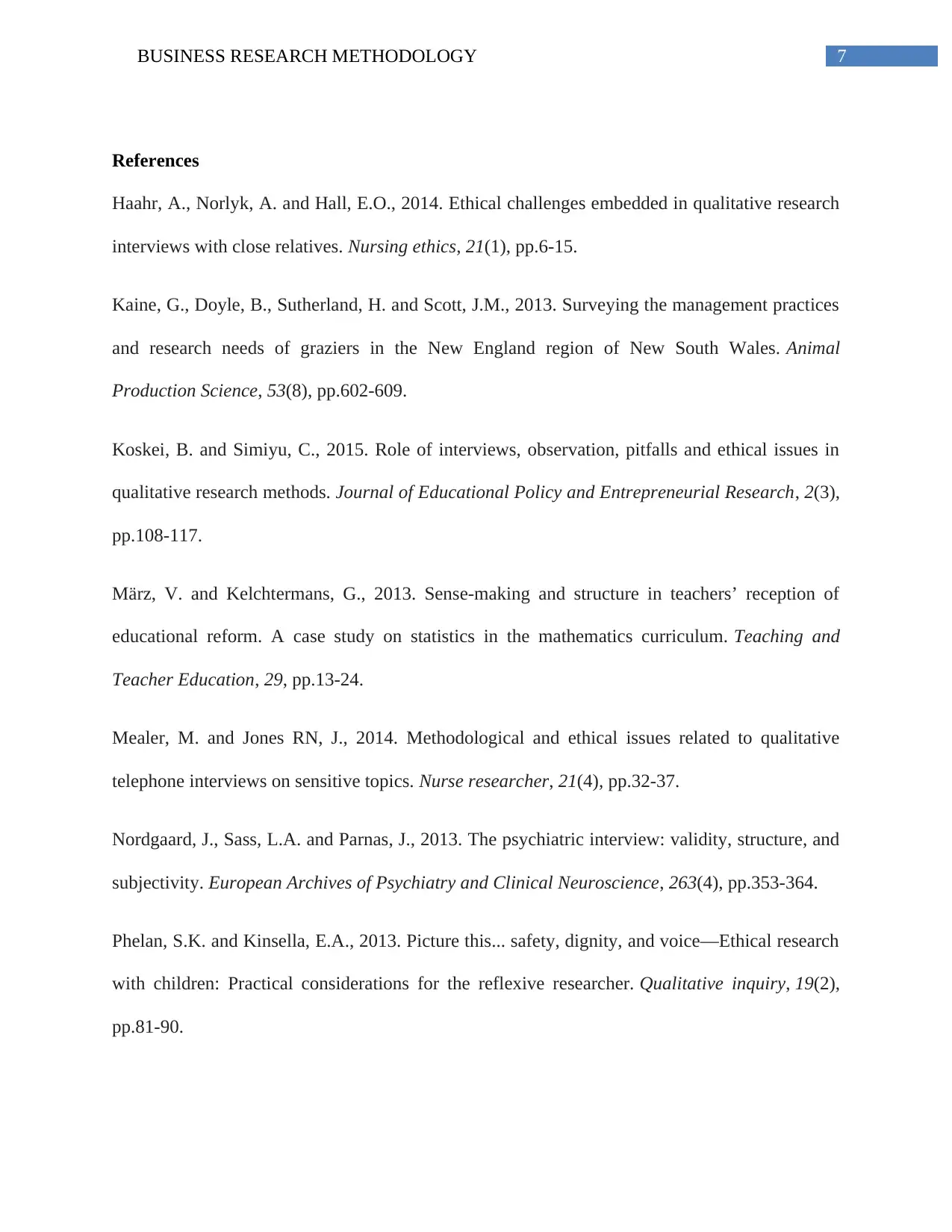
7BUSINESS RESEARCH METHODOLOGY
References
Haahr, A., Norlyk, A. and Hall, E.O., 2014. Ethical challenges embedded in qualitative research
interviews with close relatives. Nursing ethics, 21(1), pp.6-15.
Kaine, G., Doyle, B., Sutherland, H. and Scott, J.M., 2013. Surveying the management practices
and research needs of graziers in the New England region of New South Wales. Animal
Production Science, 53(8), pp.602-609.
Koskei, B. and Simiyu, C., 2015. Role of interviews, observation, pitfalls and ethical issues in
qualitative research methods. Journal of Educational Policy and Entrepreneurial Research, 2(3),
pp.108-117.
März, V. and Kelchtermans, G., 2013. Sense-making and structure in teachers’ reception of
educational reform. A case study on statistics in the mathematics curriculum. Teaching and
Teacher Education, 29, pp.13-24.
Mealer, M. and Jones RN, J., 2014. Methodological and ethical issues related to qualitative
telephone interviews on sensitive topics. Nurse researcher, 21(4), pp.32-37.
Nordgaard, J., Sass, L.A. and Parnas, J., 2013. The psychiatric interview: validity, structure, and
subjectivity. European Archives of Psychiatry and Clinical Neuroscience, 263(4), pp.353-364.
Phelan, S.K. and Kinsella, E.A., 2013. Picture this... safety, dignity, and voice—Ethical research
with children: Practical considerations for the reflexive researcher. Qualitative inquiry, 19(2),
pp.81-90.
References
Haahr, A., Norlyk, A. and Hall, E.O., 2014. Ethical challenges embedded in qualitative research
interviews with close relatives. Nursing ethics, 21(1), pp.6-15.
Kaine, G., Doyle, B., Sutherland, H. and Scott, J.M., 2013. Surveying the management practices
and research needs of graziers in the New England region of New South Wales. Animal
Production Science, 53(8), pp.602-609.
Koskei, B. and Simiyu, C., 2015. Role of interviews, observation, pitfalls and ethical issues in
qualitative research methods. Journal of Educational Policy and Entrepreneurial Research, 2(3),
pp.108-117.
März, V. and Kelchtermans, G., 2013. Sense-making and structure in teachers’ reception of
educational reform. A case study on statistics in the mathematics curriculum. Teaching and
Teacher Education, 29, pp.13-24.
Mealer, M. and Jones RN, J., 2014. Methodological and ethical issues related to qualitative
telephone interviews on sensitive topics. Nurse researcher, 21(4), pp.32-37.
Nordgaard, J., Sass, L.A. and Parnas, J., 2013. The psychiatric interview: validity, structure, and
subjectivity. European Archives of Psychiatry and Clinical Neuroscience, 263(4), pp.353-364.
Phelan, S.K. and Kinsella, E.A., 2013. Picture this... safety, dignity, and voice—Ethical research
with children: Practical considerations for the reflexive researcher. Qualitative inquiry, 19(2),
pp.81-90.
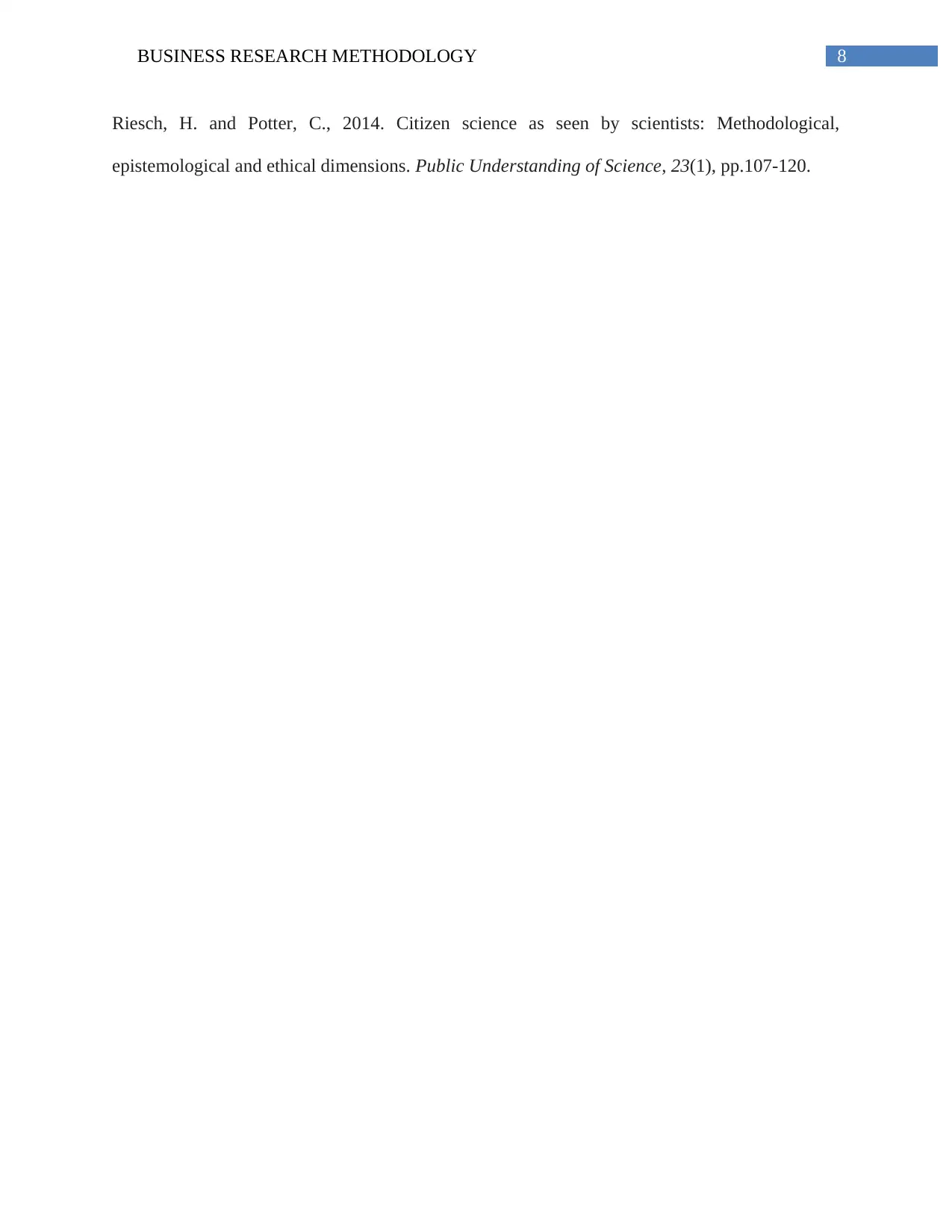
8BUSINESS RESEARCH METHODOLOGY
Riesch, H. and Potter, C., 2014. Citizen science as seen by scientists: Methodological,
epistemological and ethical dimensions. Public Understanding of Science, 23(1), pp.107-120.
Riesch, H. and Potter, C., 2014. Citizen science as seen by scientists: Methodological,
epistemological and ethical dimensions. Public Understanding of Science, 23(1), pp.107-120.
⊘ This is a preview!⊘
Do you want full access?
Subscribe today to unlock all pages.

Trusted by 1+ million students worldwide
1 out of 9
Related Documents
Your All-in-One AI-Powered Toolkit for Academic Success.
+13062052269
info@desklib.com
Available 24*7 on WhatsApp / Email
![[object Object]](/_next/static/media/star-bottom.7253800d.svg)
Unlock your academic potential
Copyright © 2020–2025 A2Z Services. All Rights Reserved. Developed and managed by ZUCOL.





